Emirates Airlines: Competitive Strategy and Analysis Report
VerifiedAdded on 2022/01/17
|6
|1764
|35
Report
AI Summary
This report provides a comprehensive analysis of Emirates Airlines, examining its management strategies, competitive advantages, and market position. It begins with an overview of the airline's history, growth, and goals, highlighting its innovative use of technology and strategic alliances. The report delves into Emirates' differentiation strategy, Dubai-based hub-and-spoke model, and the factors behind its financial success, including geographic location and government support. It also explores the airline's strengths and weaknesses, including the challenges posed by competitors like British Airways and Singapore Airlines, and the impact of economic and political factors. A SWOT analysis is included, along with recommendations for maintaining competitiveness and profitability in the evolving airline industry.
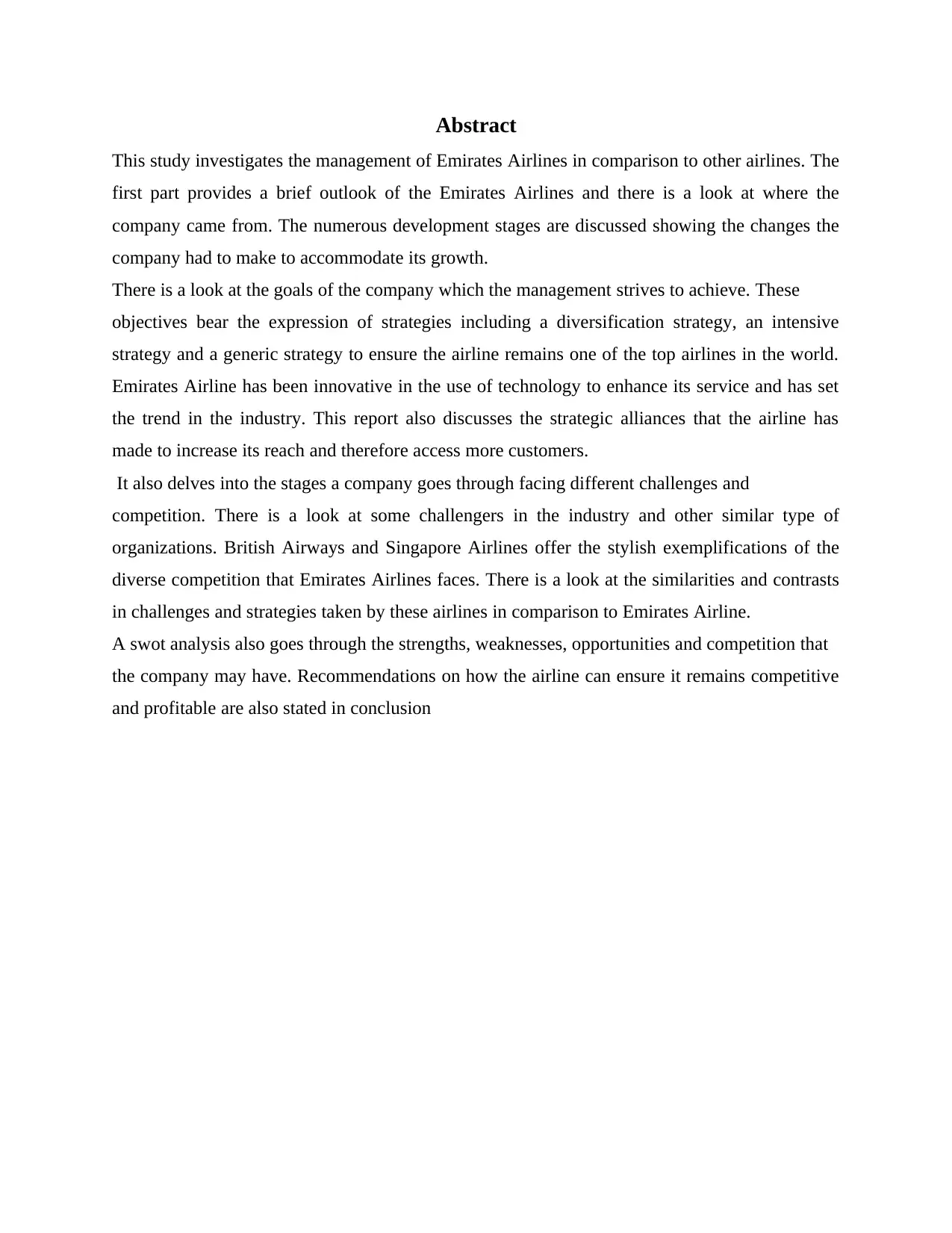
Abstract
This study investigates the management of Emirates Airlines in comparison to other airlines. The
first part provides a brief outlook of the Emirates Airlines and there is a look at where the
company came from. The numerous development stages are discussed showing the changes the
company had to make to accommodate its growth.
There is a look at the goals of the company which the management strives to achieve. These
objectives bear the expression of strategies including a diversification strategy, an intensive
strategy and a generic strategy to ensure the airline remains one of the top airlines in the world.
Emirates Airline has been innovative in the use of technology to enhance its service and has set
the trend in the industry. This report also discusses the strategic alliances that the airline has
made to increase its reach and therefore access more customers.
It also delves into the stages a company goes through facing different challenges and
competition. There is a look at some challengers in the industry and other similar type of
organizations. British Airways and Singapore Airlines offer the stylish exemplifications of the
diverse competition that Emirates Airlines faces. There is a look at the similarities and contrasts
in challenges and strategies taken by these airlines in comparison to Emirates Airline.
A swot analysis also goes through the strengths, weaknesses, opportunities and competition that
the company may have. Recommendations on how the airline can ensure it remains competitive
and profitable are also stated in conclusion
This study investigates the management of Emirates Airlines in comparison to other airlines. The
first part provides a brief outlook of the Emirates Airlines and there is a look at where the
company came from. The numerous development stages are discussed showing the changes the
company had to make to accommodate its growth.
There is a look at the goals of the company which the management strives to achieve. These
objectives bear the expression of strategies including a diversification strategy, an intensive
strategy and a generic strategy to ensure the airline remains one of the top airlines in the world.
Emirates Airline has been innovative in the use of technology to enhance its service and has set
the trend in the industry. This report also discusses the strategic alliances that the airline has
made to increase its reach and therefore access more customers.
It also delves into the stages a company goes through facing different challenges and
competition. There is a look at some challengers in the industry and other similar type of
organizations. British Airways and Singapore Airlines offer the stylish exemplifications of the
diverse competition that Emirates Airlines faces. There is a look at the similarities and contrasts
in challenges and strategies taken by these airlines in comparison to Emirates Airline.
A swot analysis also goes through the strengths, weaknesses, opportunities and competition that
the company may have. Recommendations on how the airline can ensure it remains competitive
and profitable are also stated in conclusion
Paraphrase This Document
Need a fresh take? Get an instant paraphrase of this document with our AI Paraphraser
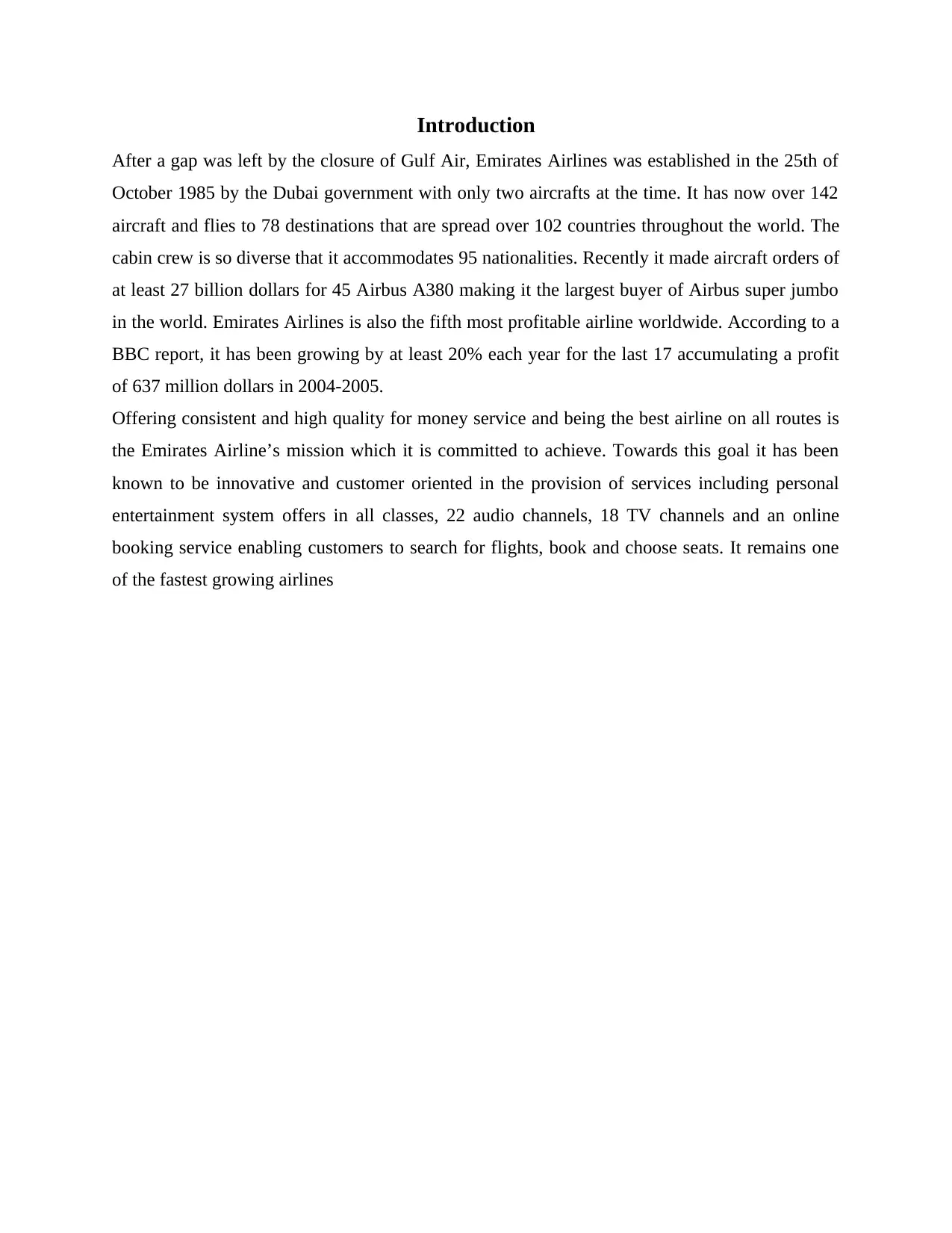
Introduction
After a gap was left by the closure of Gulf Air, Emirates Airlines was established in the 25th of
October 1985 by the Dubai government with only two aircrafts at the time. It has now over 142
aircraft and flies to 78 destinations that are spread over 102 countries throughout the world. The
cabin crew is so diverse that it accommodates 95 nationalities. Recently it made aircraft orders of
at least 27 billion dollars for 45 Airbus A380 making it the largest buyer of Airbus super jumbo
in the world. Emirates Airlines is also the fifth most profitable airline worldwide. According to a
BBC report, it has been growing by at least 20% each year for the last 17 accumulating a profit
of 637 million dollars in 2004-2005.
Offering consistent and high quality for money service and being the best airline on all routes is
the Emirates Airline’s mission which it is committed to achieve. Towards this goal it has been
known to be innovative and customer oriented in the provision of services including personal
entertainment system offers in all classes, 22 audio channels, 18 TV channels and an online
booking service enabling customers to search for flights, book and choose seats. It remains one
of the fastest growing airlines
After a gap was left by the closure of Gulf Air, Emirates Airlines was established in the 25th of
October 1985 by the Dubai government with only two aircrafts at the time. It has now over 142
aircraft and flies to 78 destinations that are spread over 102 countries throughout the world. The
cabin crew is so diverse that it accommodates 95 nationalities. Recently it made aircraft orders of
at least 27 billion dollars for 45 Airbus A380 making it the largest buyer of Airbus super jumbo
in the world. Emirates Airlines is also the fifth most profitable airline worldwide. According to a
BBC report, it has been growing by at least 20% each year for the last 17 accumulating a profit
of 637 million dollars in 2004-2005.
Offering consistent and high quality for money service and being the best airline on all routes is
the Emirates Airline’s mission which it is committed to achieve. Towards this goal it has been
known to be innovative and customer oriented in the provision of services including personal
entertainment system offers in all classes, 22 audio channels, 18 TV channels and an online
booking service enabling customers to search for flights, book and choose seats. It remains one
of the fastest growing airlines
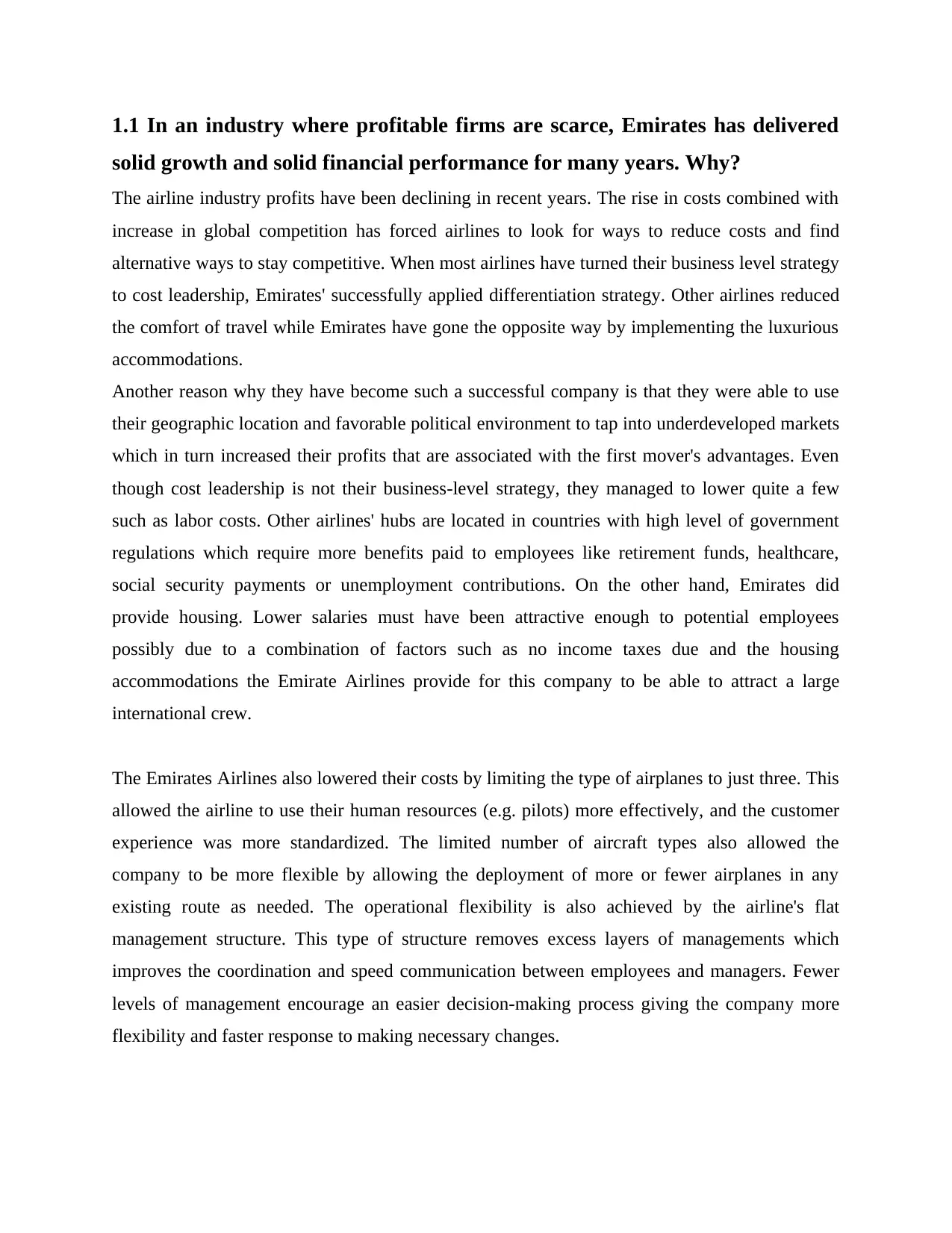
1.1 In an industry where profitable firms are scarce, Emirates has delivered
solid growth and solid financial performance for many years. Why?
The airline industry profits have been declining in recent years. The rise in costs combined with
increase in global competition has forced airlines to look for ways to reduce costs and find
alternative ways to stay competitive. When most airlines have turned their business level strategy
to cost leadership, Emirates' successfully applied differentiation strategy. Other airlines reduced
the comfort of travel while Emirates have gone the opposite way by implementing the luxurious
accommodations.
Another reason why they have become such a successful company is that they were able to use
their geographic location and favorable political environment to tap into underdeveloped markets
which in turn increased their profits that are associated with the first mover's advantages. Even
though cost leadership is not their business-level strategy, they managed to lower quite a few
such as labor costs. Other airlines' hubs are located in countries with high level of government
regulations which require more benefits paid to employees like retirement funds, healthcare,
social security payments or unemployment contributions. On the other hand, Emirates did
provide housing. Lower salaries must have been attractive enough to potential employees
possibly due to a combination of factors such as no income taxes due and the housing
accommodations the Emirate Airlines provide for this company to be able to attract a large
international crew.
The Emirates Airlines also lowered their costs by limiting the type of airplanes to just three. This
allowed the airline to use their human resources (e.g. pilots) more effectively, and the customer
experience was more standardized. The limited number of aircraft types also allowed the
company to be more flexible by allowing the deployment of more or fewer airplanes in any
existing route as needed. The operational flexibility is also achieved by the airline's flat
management structure. This type of structure removes excess layers of managements which
improves the coordination and speed communication between employees and managers. Fewer
levels of management encourage an easier decision-making process giving the company more
flexibility and faster response to making necessary changes.
solid growth and solid financial performance for many years. Why?
The airline industry profits have been declining in recent years. The rise in costs combined with
increase in global competition has forced airlines to look for ways to reduce costs and find
alternative ways to stay competitive. When most airlines have turned their business level strategy
to cost leadership, Emirates' successfully applied differentiation strategy. Other airlines reduced
the comfort of travel while Emirates have gone the opposite way by implementing the luxurious
accommodations.
Another reason why they have become such a successful company is that they were able to use
their geographic location and favorable political environment to tap into underdeveloped markets
which in turn increased their profits that are associated with the first mover's advantages. Even
though cost leadership is not their business-level strategy, they managed to lower quite a few
such as labor costs. Other airlines' hubs are located in countries with high level of government
regulations which require more benefits paid to employees like retirement funds, healthcare,
social security payments or unemployment contributions. On the other hand, Emirates did
provide housing. Lower salaries must have been attractive enough to potential employees
possibly due to a combination of factors such as no income taxes due and the housing
accommodations the Emirate Airlines provide for this company to be able to attract a large
international crew.
The Emirates Airlines also lowered their costs by limiting the type of airplanes to just three. This
allowed the airline to use their human resources (e.g. pilots) more effectively, and the customer
experience was more standardized. The limited number of aircraft types also allowed the
company to be more flexible by allowing the deployment of more or fewer airplanes in any
existing route as needed. The operational flexibility is also achieved by the airline's flat
management structure. This type of structure removes excess layers of managements which
improves the coordination and speed communication between employees and managers. Fewer
levels of management encourage an easier decision-making process giving the company more
flexibility and faster response to making necessary changes.
⊘ This is a preview!⊘
Do you want full access?
Subscribe today to unlock all pages.

Trusted by 1+ million students worldwide
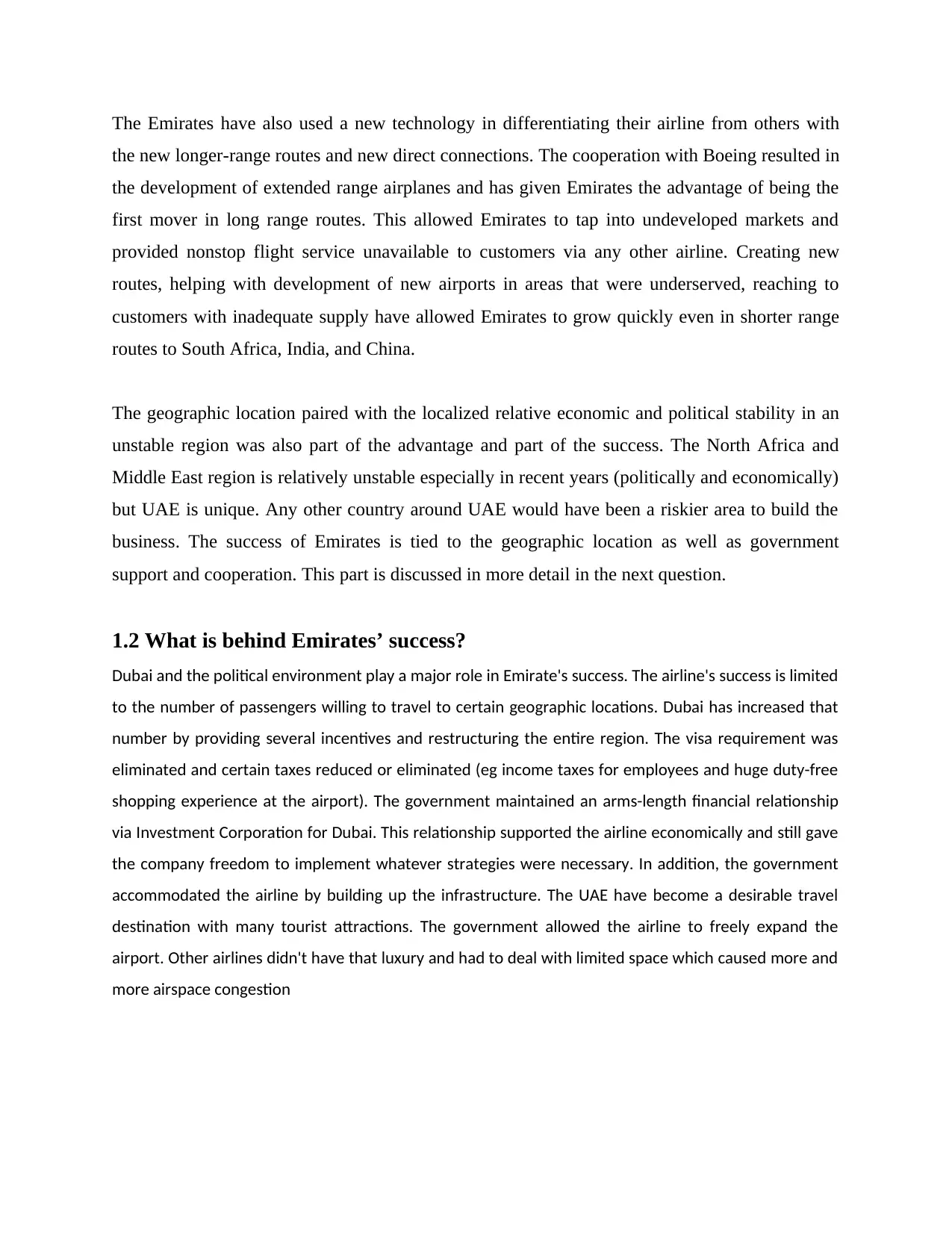
The Emirates have also used a new technology in differentiating their airline from others with
the new longer-range routes and new direct connections. The cooperation with Boeing resulted in
the development of extended range airplanes and has given Emirates the advantage of being the
first mover in long range routes. This allowed Emirates to tap into undeveloped markets and
provided nonstop flight service unavailable to customers via any other airline. Creating new
routes, helping with development of new airports in areas that were underserved, reaching to
customers with inadequate supply have allowed Emirates to grow quickly even in shorter range
routes to South Africa, India, and China.
The geographic location paired with the localized relative economic and political stability in an
unstable region was also part of the advantage and part of the success. The North Africa and
Middle East region is relatively unstable especially in recent years (politically and economically)
but UAE is unique. Any other country around UAE would have been a riskier area to build the
business. The success of Emirates is tied to the geographic location as well as government
support and cooperation. This part is discussed in more detail in the next question.
1.2 What is behind Emirates’ success?
Dubai and the political environment play a major role in Emirate's success. The airline's success is limited
to the number of passengers willing to travel to certain geographic locations. Dubai has increased that
number by providing several incentives and restructuring the entire region. The visa requirement was
eliminated and certain taxes reduced or eliminated (eg income taxes for employees and huge duty-free
shopping experience at the airport). The government maintained an arms-length financial relationship
via Investment Corporation for Dubai. This relationship supported the airline economically and still gave
the company freedom to implement whatever strategies were necessary. In addition, the government
accommodated the airline by building up the infrastructure. The UAE have become a desirable travel
destination with many tourist attractions. The government allowed the airline to freely expand the
airport. Other airlines didn't have that luxury and had to deal with limited space which caused more and
more airspace congestion
the new longer-range routes and new direct connections. The cooperation with Boeing resulted in
the development of extended range airplanes and has given Emirates the advantage of being the
first mover in long range routes. This allowed Emirates to tap into undeveloped markets and
provided nonstop flight service unavailable to customers via any other airline. Creating new
routes, helping with development of new airports in areas that were underserved, reaching to
customers with inadequate supply have allowed Emirates to grow quickly even in shorter range
routes to South Africa, India, and China.
The geographic location paired with the localized relative economic and political stability in an
unstable region was also part of the advantage and part of the success. The North Africa and
Middle East region is relatively unstable especially in recent years (politically and economically)
but UAE is unique. Any other country around UAE would have been a riskier area to build the
business. The success of Emirates is tied to the geographic location as well as government
support and cooperation. This part is discussed in more detail in the next question.
1.2 What is behind Emirates’ success?
Dubai and the political environment play a major role in Emirate's success. The airline's success is limited
to the number of passengers willing to travel to certain geographic locations. Dubai has increased that
number by providing several incentives and restructuring the entire region. The visa requirement was
eliminated and certain taxes reduced or eliminated (eg income taxes for employees and huge duty-free
shopping experience at the airport). The government maintained an arms-length financial relationship
via Investment Corporation for Dubai. This relationship supported the airline economically and still gave
the company freedom to implement whatever strategies were necessary. In addition, the government
accommodated the airline by building up the infrastructure. The UAE have become a desirable travel
destination with many tourist attractions. The government allowed the airline to freely expand the
airport. Other airlines didn't have that luxury and had to deal with limited space which caused more and
more airspace congestion
Paraphrase This Document
Need a fresh take? Get an instant paraphrase of this document with our AI Paraphraser
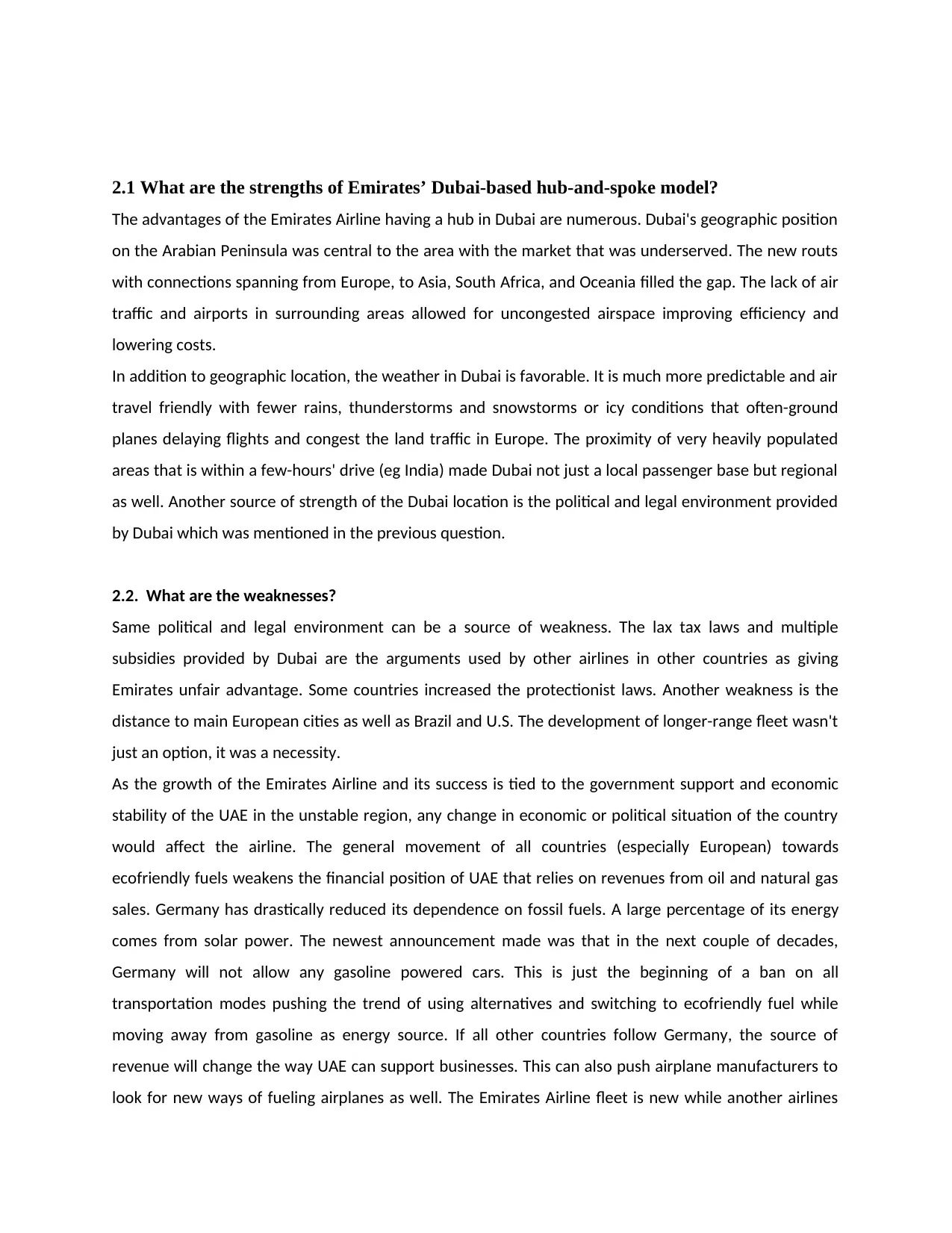
2.1 What are the strengths of Emirates’ Dubai-based hub-and-spoke model?
The advantages of the Emirates Airline having a hub in Dubai are numerous. Dubai's geographic position
on the Arabian Peninsula was central to the area with the market that was underserved. The new routs
with connections spanning from Europe, to Asia, South Africa, and Oceania filled the gap. The lack of air
traffic and airports in surrounding areas allowed for uncongested airspace improving efficiency and
lowering costs.
In addition to geographic location, the weather in Dubai is favorable. It is much more predictable and air
travel friendly with fewer rains, thunderstorms and snowstorms or icy conditions that often-ground
planes delaying flights and congest the land traffic in Europe. The proximity of very heavily populated
areas that is within a few-hours' drive (eg India) made Dubai not just a local passenger base but regional
as well. Another source of strength of the Dubai location is the political and legal environment provided
by Dubai which was mentioned in the previous question.
2.2. What are the weaknesses?
Same political and legal environment can be a source of weakness. The lax tax laws and multiple
subsidies provided by Dubai are the arguments used by other airlines in other countries as giving
Emirates unfair advantage. Some countries increased the protectionist laws. Another weakness is the
distance to main European cities as well as Brazil and U.S. The development of longer-range fleet wasn't
just an option, it was a necessity.
As the growth of the Emirates Airline and its success is tied to the government support and economic
stability of the UAE in the unstable region, any change in economic or political situation of the country
would affect the airline. The general movement of all countries (especially European) towards
ecofriendly fuels weakens the financial position of UAE that relies on revenues from oil and natural gas
sales. Germany has drastically reduced its dependence on fossil fuels. A large percentage of its energy
comes from solar power. The newest announcement made was that in the next couple of decades,
Germany will not allow any gasoline powered cars. This is just the beginning of a ban on all
transportation modes pushing the trend of using alternatives and switching to ecofriendly fuel while
moving away from gasoline as energy source. If all other countries follow Germany, the source of
revenue will change the way UAE can support businesses. This can also push airplane manufacturers to
look for new ways of fueling airplanes as well. The Emirates Airline fleet is new while another airlines
The advantages of the Emirates Airline having a hub in Dubai are numerous. Dubai's geographic position
on the Arabian Peninsula was central to the area with the market that was underserved. The new routs
with connections spanning from Europe, to Asia, South Africa, and Oceania filled the gap. The lack of air
traffic and airports in surrounding areas allowed for uncongested airspace improving efficiency and
lowering costs.
In addition to geographic location, the weather in Dubai is favorable. It is much more predictable and air
travel friendly with fewer rains, thunderstorms and snowstorms or icy conditions that often-ground
planes delaying flights and congest the land traffic in Europe. The proximity of very heavily populated
areas that is within a few-hours' drive (eg India) made Dubai not just a local passenger base but regional
as well. Another source of strength of the Dubai location is the political and legal environment provided
by Dubai which was mentioned in the previous question.
2.2. What are the weaknesses?
Same political and legal environment can be a source of weakness. The lax tax laws and multiple
subsidies provided by Dubai are the arguments used by other airlines in other countries as giving
Emirates unfair advantage. Some countries increased the protectionist laws. Another weakness is the
distance to main European cities as well as Brazil and U.S. The development of longer-range fleet wasn't
just an option, it was a necessity.
As the growth of the Emirates Airline and its success is tied to the government support and economic
stability of the UAE in the unstable region, any change in economic or political situation of the country
would affect the airline. The general movement of all countries (especially European) towards
ecofriendly fuels weakens the financial position of UAE that relies on revenues from oil and natural gas
sales. Germany has drastically reduced its dependence on fossil fuels. A large percentage of its energy
comes from solar power. The newest announcement made was that in the next couple of decades,
Germany will not allow any gasoline powered cars. This is just the beginning of a ban on all
transportation modes pushing the trend of using alternatives and switching to ecofriendly fuel while
moving away from gasoline as energy source. If all other countries follow Germany, the source of
revenue will change the way UAE can support businesses. This can also push airplane manufacturers to
look for new ways of fueling airplanes as well. The Emirates Airline fleet is new while another airlines

fleet is old. This means other airlines will probably buy newer airplanes sooner than Emirates when the
age requires it. The advantage Emirates have now with new planes will not last.
age requires it. The advantage Emirates have now with new planes will not last.
⊘ This is a preview!⊘
Do you want full access?
Subscribe today to unlock all pages.

Trusted by 1+ million students worldwide
1 out of 6
Related Documents
Your All-in-One AI-Powered Toolkit for Academic Success.
+13062052269
info@desklib.com
Available 24*7 on WhatsApp / Email
![[object Object]](/_next/static/media/star-bottom.7253800d.svg)
Unlock your academic potential
Copyright © 2020–2025 A2Z Services. All Rights Reserved. Developed and managed by ZUCOL.





